Analysis
CA120: The old switcheroo
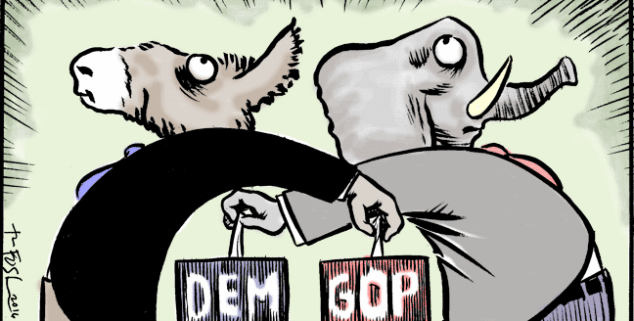 The political switcheroo. (Illustration by Tim Foster, Capitol Weekly)
The political switcheroo. (Illustration by Tim Foster, Capitol Weekly)One of the recent story lines in the presidential contest is the idea of voters casting their ballots strategically. This media narrative suggests that voters will cast a ballot for a candidate — not because they support that candidate, but because it is the best strategic option toward a desired outcome.
This game theory analysis of elections has been most used in states with fully open primaries, same day registration, or relaxed laws with regard to partisan identification.
As the California presidential primary approaches, political consultant Rob Stutzman and the firm of McNally/Temple are heading up an effort to block Donald Trump
In these states, Democratic-leaning voters, determining that their vote isn’t going to make a difference in deciding the Democratic nomination, switch to the Republican primary in order to vote against Trump.
I had the benefit of actually seeing this in action during the Iowa caucuses.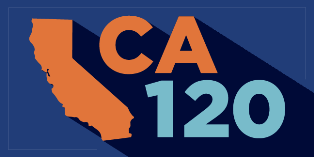
A friend was able to get me on a text chain with friends who had gone to their Republican caucuses in a small town near Sioux City. These voters intended to do whatever was strategic to block Trump from getting the state’s delegates. But, as the vote came, they were still debating whether to support Ted Cruz, Marco Rubio or Ben Carson. (Rubio ended up winning the caucus by 230 votes, meaning their strategic votes didn’t make the difference, but they could have been the winning margin in the Democratic caucus next door where Bernie Sanders won by just 5 votes.)
As the California presidential primary approaches, political consultant Rob Stutzman and the firm of McNally/Temple are heading up an effort to block Donald Trump, and they see the benefit of a broader Republican registration to help their efforts.
According to Stutzman, they see this is more than just strategic voting: They see an opportunity “for Republicans to register voters into the party, then fight to keep them.”
Jen Maiser, a nonpartisan voter who has worked closely with a number of California political consulting firms, is one of these voters. In her words, she believes “the most important thing I could do with my June vote was to switch my party affiliation to Republican in order to vote for a non-Trump presidential candidate and help push the delegate numbers toward a contested Republican convention in Cleveland.” She characterized her Republican registration as “a purely defensive maneuver against Donald Trump.”
Clearly “strategic voting” happens, as seen in the examples above, but it is likely just a product of the hyper-political individuals like Jen – people so engaged that they are reading the polls and understand the intricacies of the primary process.
They see how crashing a caucus or primary to vote for a moderate candidate of another party can help them achieve an outcome or be a better expression of their political will.
Complicating things for June 7, is that a California Democratic or independent voter who wants to vote strategically to block Trump has to act now.
The registration deadline of May 23 is quickly approaching. And someone intending to vote against trump in the closed Republican Primary would have to re-register as a Republican, and then, presumably, re-register as a Democrat after June 8.
Exploring the voter file for evidence of this phenomenon, we can see that voters re-registering Republican has indeed spiked. With county registration files still being updated, we have flagged 13,000 voters who have switched from no-party-preference to Republican. We can presume that most of these registrations are conservatives actually wanting to vote in that primary for someone, not strategically minded voters like Jen. But some could be. More interesting is the approximately 6,500 voters converting from Democrat to Republican in March. That previously Democratic universe might hold a larger number of partisan liberals who are planning to strategically vote in the Republican primary.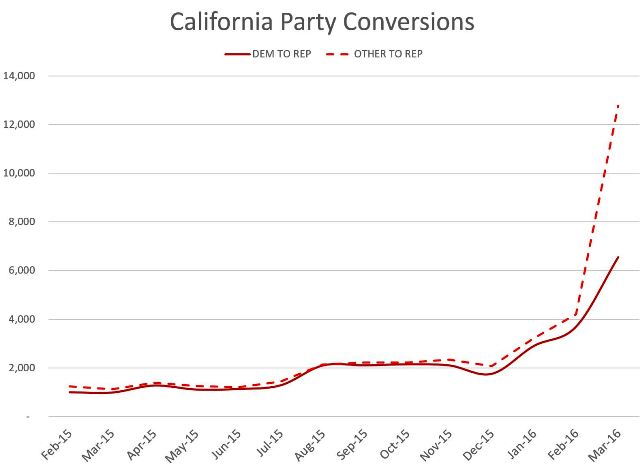
However, put into scale, this trend of conversions to Republicans is miniscule. California has more than 17 million voters, nearly 5 million of these are Republicans and half of them are likely to turnout in the coming election. Even if the current rate of registrations by Democrats to Republicans tripled, and the vast majority were strategic voters, it would just be a 1% impact on the race. And this impact would be marginalized if it was spread among strategic voters casting ballots for Cruz and Kasich, and nullified if some were voting for Trump under the strategic assumption that he would bring havoc to the Republican party or be easier for a Democrat to beat in November.
Additionally, this registration to become a Republican is currently being swamped by voters headed in the all other directions. As the following chart shows, the greater shift is among non-partisans converting to become Democratic, and until last month there was a greater trend of Democrats becoming non-partisan than non-partisans becoming Republican.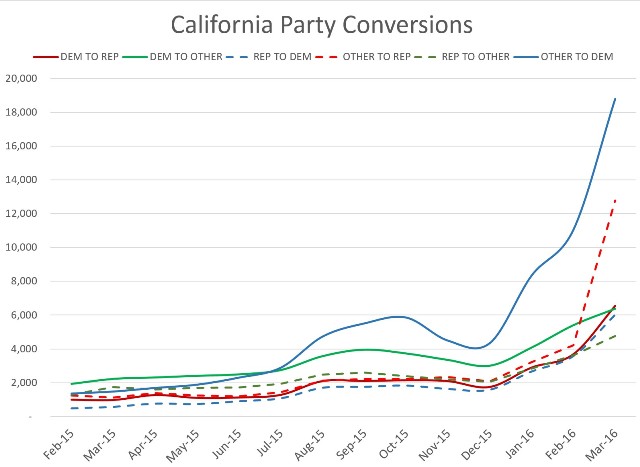
Looking at a consolidated chart of just the shifts to each party and the two major parties, along with shifts to independent status, it is clear that Republican conversions are on a dramatic uptick, but still at slightly lower numbers than Democratic conversions.
And, finally, there is the important fact that Democrats are about 45% of the voters in California, with Republicans less than 30%, so the analysis can benefit from a proportional look. And this, again, reinforces how low the numbers are, with the rate of Republican conversions spiking in March, but still staying within single-digits of new registrations in the state, and being lower than voters converting to Democrat.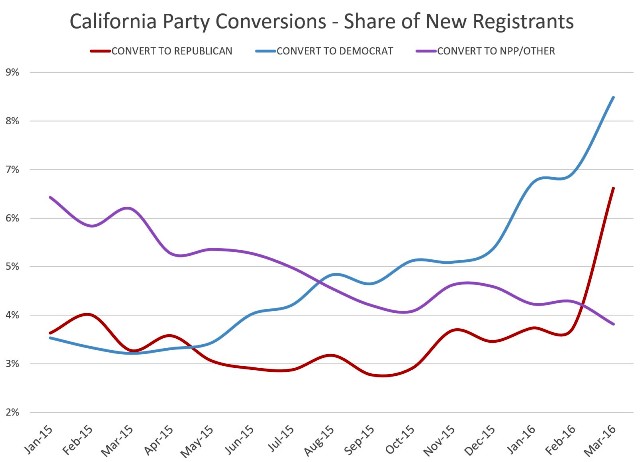
Will progressives get on a Republican registration bandwagon to play spoiler for Donald Trump, potentially boosting the more palatable John Kasich, or holding their noses to vote for a strident, but front-running Ted Cruz? Maybe the payoff of saying they helped stop Trump would be worth it. We will keep tracking it, but the data isn’t currently showing evidence that this is happening in more than a few isolated cases, and it is far from being able to impact the contest in June.
—
Ed’s Note: Paul Mitchell, a regular contributor to Capitol Weekly, is the creator of the CA120 column, which explores 2016 election issues in California. He is vice president of Political Data Inc., and owner of Redistricting Partners, a bipartisan political strategy and research company.
Want to see more stories like this? Sign up for The Roundup, the free daily newsletter about California politics from the editors of Capitol Weekly. Stay up to date on the news you need to know.
Sign up below, then look for a confirmation email in your inbox.

This is a classic example of ‘social dilemma’, i.e., a game theory paradox where acting to maximize short-term self-interest hurts every player. Carried to the extreme tactical destroys the election process. The problem, incidentally, is much worse in the UK, where they have many parties.
The solution is for people to vote ‘cooperatively’, i.e., seeking the good of all (e.g., integrity of the political system). That means to vote on principle, not tactically. We should as a society agree that the right thing to do is to vote for the candidate whom we think is best, regardless of outcome. That approach satisfies the moral condition of Kant’s categorical imperative. See: http://bit.ly/1T7kCBi
Canada just replaced one chicken hawk with another chicken hawk… the jew British monarchy wants to ban Trump because he will disrupt the Afghanistan-Mexico heroine flow, they want chicken hawk Jew Sanders or Goldman Sachs puppets like Hillary or Cruz…
Steven Harper was a chicken hawk that let unrestricted immigration and drug smuggling to run rampant while having the antagonistic posture against Russia… gay boy chicken hawk Turdeau was handed down his yarmulke the same way divine monosyllable Dave Cameron got his, by looking the other way during the pedophile scandals and fúcking the dead kosher pig.